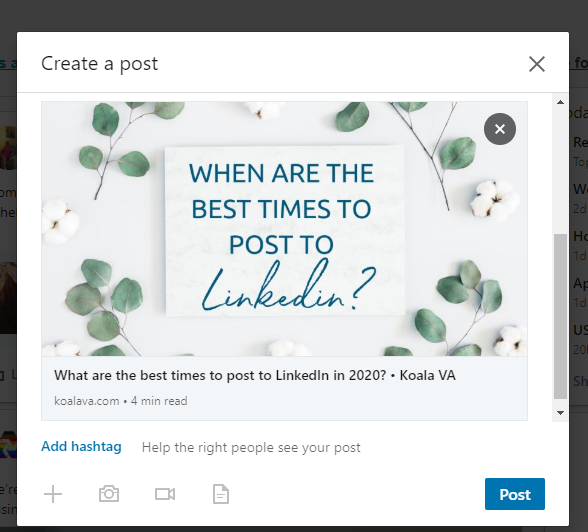If you spend any time on LinkedIn, you’ve probably heard that you should never put external links (e.g. to your website or news article etc.) in the body of your post. But why is that?
In this article, I explain why social platforms (generally) dislike external links and how you should handle them when you’re posting on LinkedIn.
Why don’t social platforms like external links?
Back in 2017, Facebook announced a change to its algorithm designed to reduce the reach of posts with click-bait and low-quality links. At the time this followed Google’s lead of penalising lower-quality content and intrusive ads and pop-ups that affected the user experience. However, in 2016, an update to the Facebook algorithm aimed to rank posts with engaging links higher in people’s feeds.
The topic of external links on social platforms is a hotly debated one. If your link is ‘good’ (i.e. not click-baity crap) then will it affect your post’s reach or not?
One explanation for social platforms penalising posts containing external links is that they don’t want users clicking away from their site. External links basically act as exits for users who then end up elsewhere on the web and, therefore, consuming less ads and generating less revenue for the platform.
Something we know for sure is that when it comes to posting videos, uploading them natively is definitely the way to go. Native videos (those uploaded directly to the social platform) will outperform YouTube links every day of the week. It doesn’t matter which platform… post your videos natively if you can.
How to handle external links on social media
‘Link in the comments’
This is the most common way people handle external links on LinkedIn and other social media platforms. You write your post and then direct readers to the comments section where they will find a link to whatever you’re talking about. This is usually just worded as ‘link in the comments’ and research has shown that posts aren’t penalised for containing this phrase.
The benefit of this approach to external links is that it keeps the body of your post looking neat and tidy and guarantees that the external link won’t affect your post’s reach.
However, the downsides are obvious:
You have to remember to post the link in the comment.
That means you have to be posting live and natively (not through a scheduler) which takes time and effort, especially if you’re managing multiple different social accounts.
Readers might not find the link.
Your link risks getting buried in a sea of comments if your post proves popular. Furthermore, unless the reader is really interested they might not even bother to go looking for it in the first place. Generally speaking, the less your audience has to do on social media the better.
You miss out on an attractive preview card in the main post.

When you post a link on social media, it will usually generate a preview card. If you don’t add the link to the body of the post then that preview card won’t be front and centre. You’ll have to attach an image, video or document separately. Again, this takes time and effort!
The edit after posting approach
Less well-known on LinkedIn is the edit-after-posting approach. This is where you create and post something without a link and then immediately edit it to add the link in.
The benefits to this approach are that your link is more visible to readers so they’re more likely to click it, and there’s evidence to suggest that it reduces the likelihood of your post being penalised for containing an external link.
However, the downsides are obvious with this approach too:
You have to remember to edit the post.
OK, so you don’t have to remember to put the link in the comments BUT you still have to remember to edit the post to add the link in. This takes the same time and effort as the ‘link in the comments’ approach.
You still miss out on an attractive preview card.
When a link is added by editing a post it usually won’t generate a preview card. As such, you still have to attach an image, video or document separately.
All of this will likely have left you wondering why on earth social platforms like LinkedIn need to make everything so damn confusing and time-consuming. If that’s how it makes you feel, you’re going to love this next bit…
LinkedIn stopped penalising posts with external links in 2020
And now for the big takeaway for those of you who find yourselves forgetting to add the link on the regular!
It appears that LinkedIn stopped penalising posts for containing external links in 2020, and based on everything I’ve seen and heard since it seems to be the case. That being said, I continue to use my own account as a guinea pig!
In Summary
No one really knows how social media algorithms work at any given time, and we also don’t know if or when LinkedIn might return to penalising external links. There’s a lot of guesswork and bet-hedging that goes on in the social media community, all of which muddies the waters for therapy business owners who just wish social media could be simpler!
So, here’s my advice:
- If you can upload a video directly to the social platform, do it. This is definitely worthwhile, but if you can’t, please don’t sweat it. The best content will find a way to shine through.
- The easiest way to manage social media (especially if you’re juggling more than one account) is to prepare your content in advance and use a scheduler to drip feed it to your audience. If that means you need to put links in the body of the content then do that.
- If you like either the ‘link in the comments’ or ‘edit after posting’ approach then stick with them. You do you because social is supposed to be fun!
